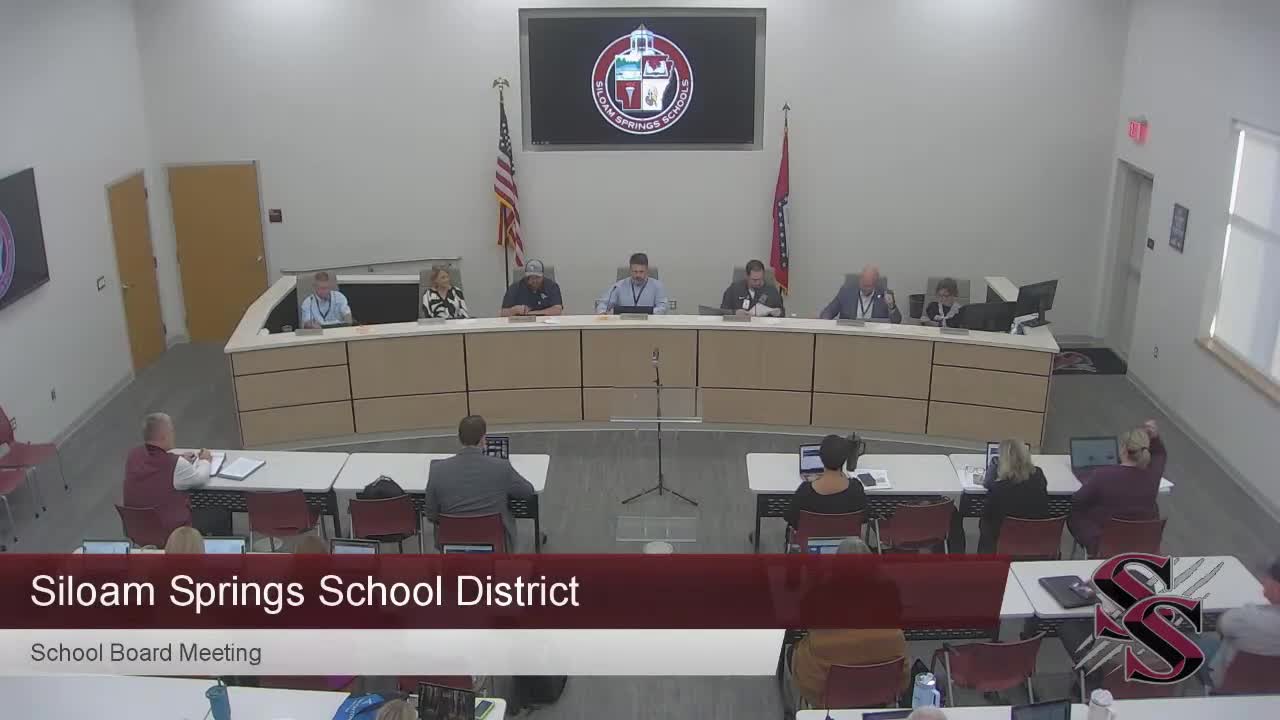Siloam Springs board debates move to neighborhood‑school model amid concerns over boundaries and staffing
October 10, 2025 | SILOAM SPRINGS SCHOOL DISTRICT, School Districts, Arkansas
This article was created by AI summarizing key points discussed. AI makes mistakes, so for full details and context, please refer to the video of the full meeting. Please report any errors so we can fix them. Report an error »

At an October Siloam Springs School District board meeting, trustees and district leaders discussed a proposed reconfiguration of elementary schools into a neighborhood‑school model intended to reduce the number of school transitions students face.
Supporters said fewer transitions should improve student learning and school continuity. "From all the data that we've been hearing for the last year and a half is that neighborhood schools are better for students to learn," said Mister Grama, board member. The proposal would move the district away from its current arrangement, which several speakers described as creating multiple transitions between buildings.
District staff framed the effort as a multi‑step process. "We've met with staff at several schools, held parent meetings and are preparing a teacher placement committee," said Patrick, a district administrator, describing outreach that has included faculty, PTO meetings and planned visits to nearby districts for best practices. He said staff are identifying scheduling and facility needs and preparing a teacher‑placement survey for staff.
Why it matters: Board members said fewer transitions can improve instruction, reduce disciplinary and emotional issues that often accompany moves between schools, and help with parental convenience and transportation. "There are greater conveniences for parents...less travel time, and that actually equals less traffic congestion," said Mister Killian, board member.
Concerns raised included how attendance boundaries will be drawn, whether neighborhood assignments could create unequal “have/ have‑not” schools, and effects on staff placement. "Parents and students are worried about where their children will go and whether lines will split friends," said Chris Horton, board member. Board members repeatedly said those concerns will be considered as staff develops specific boundary proposals.
No formal action was taken. Administrators urged the public to provide feedback; district leaders will host staff and parent meetings including parent‑teacher conference nights next week to gather input. Several board members said they want the decision process to remain transparent and iterative. "We want people's feedback. We value it," Patrick said, encouraging public engagement through district channels.
The district plans additional facility reviews (minor plumbing and restroom modifications were mentioned as likely needed), staff placement planning and parent outreach before any final adoption. Board members committed to consult demographic and growth data, and to work with principals and HR to limit disruption to teachers and support staff.
Board members acknowledged that reconfiguration would involve short‑term disruption but argued the district may gain long‑term academic and operational benefits if implemented carefully.
Supporters said fewer transitions should improve student learning and school continuity. "From all the data that we've been hearing for the last year and a half is that neighborhood schools are better for students to learn," said Mister Grama, board member. The proposal would move the district away from its current arrangement, which several speakers described as creating multiple transitions between buildings.
District staff framed the effort as a multi‑step process. "We've met with staff at several schools, held parent meetings and are preparing a teacher placement committee," said Patrick, a district administrator, describing outreach that has included faculty, PTO meetings and planned visits to nearby districts for best practices. He said staff are identifying scheduling and facility needs and preparing a teacher‑placement survey for staff.
Why it matters: Board members said fewer transitions can improve instruction, reduce disciplinary and emotional issues that often accompany moves between schools, and help with parental convenience and transportation. "There are greater conveniences for parents...less travel time, and that actually equals less traffic congestion," said Mister Killian, board member.
Concerns raised included how attendance boundaries will be drawn, whether neighborhood assignments could create unequal “have/ have‑not” schools, and effects on staff placement. "Parents and students are worried about where their children will go and whether lines will split friends," said Chris Horton, board member. Board members repeatedly said those concerns will be considered as staff develops specific boundary proposals.
No formal action was taken. Administrators urged the public to provide feedback; district leaders will host staff and parent meetings including parent‑teacher conference nights next week to gather input. Several board members said they want the decision process to remain transparent and iterative. "We want people's feedback. We value it," Patrick said, encouraging public engagement through district channels.
The district plans additional facility reviews (minor plumbing and restroom modifications were mentioned as likely needed), staff placement planning and parent outreach before any final adoption. Board members committed to consult demographic and growth data, and to work with principals and HR to limit disruption to teachers and support staff.
Board members acknowledged that reconfiguration would involve short‑term disruption but argued the district may gain long‑term academic and operational benefits if implemented carefully.
Don't Miss a Word: See the Full Meeting!
Go beyond summaries. Unlock every video, transcript, and key insight with a Founder Membership.
✓
Get instant access to full meeting videos
✓
Search and clip any phrase from complete transcripts
✓
Receive AI-powered summaries & custom alerts
✓
Enjoy lifetime, unrestricted access to government data
30-day money-back guarantee

